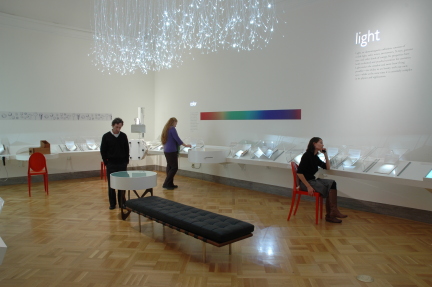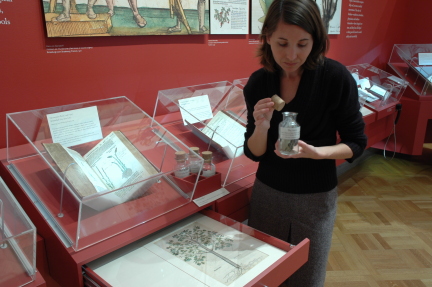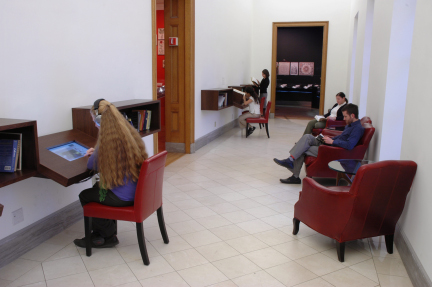- About MAA
- Membership
- MAA Publications
- Periodicals
- Blogs
- MAA Book Series
- MAA Press (an imprint of the AMS)
- MAA Notes
- MAA Reviews
- Mathematical Communication
- Information for Libraries
- Author Resources
- Advertise with MAA
- Meetings
- Competitions
- Programs
- Communities
- MAA Sections
- SIGMAA
- MAA Connect
- Students
- MAA Awards
- Awards Booklets
- Writing Awards
- Teaching Awards
- Service Awards
- Research Awards
- Lecture Awards
- Putnam Competition Individual and Team Winners
- D. E. Shaw Group AMC 8 Awards & Certificates
- Maryam Mirzakhani AMC 10 A Awards & Certificates
- Two Sigma AMC 10 B Awards & Certificates
- Jane Street AMC 12 A Awards & Certificates
- Akamai AMC 12 B Awards & Certificates
- High School Teachers
- News
You are here
Discovering the Beauty of Science - Beautiful Science at the Huntington Library
Opened in Fall 2008, “Beautiful Science: Ideas that Changed the World” is now part of the permanent exhibitions at the Huntington Library. The aptly named exhibit showcases four areas to discover and explore: astronomy, light, medicine, and natural history. Not only is the material accessible to those less familiar with the sciences, it also includes some real gems for those who have a deep appreciation for the sciences, including mathematics. Of particular interest to mathematically minded visitors may be the appearance of familiar names from the history of mathematics in multiple areas of the exhibit. For example, works by Sir Isaac Newton and Johannes Kepler appear in both the astronomy and light sections; Rene Descartes’ works are in both medicine and light. The Beautiful Science exhibit helps to highlight the broad-ranging capabilities of these prolific mathematicians, and also the pervasiveness of mathematical ideas throughout the sciences.
Figure 2. The Light Gallery in the Beautiful Science exhibit (© The Huntington Library)
Visitors are invited to tour the four rooms of the Beautiful Science exhibit at their own pace, viewing original books and documents including:
- Galileo Galilei’s 1610 Starry Messenger (the Huntington owns two copies of this masterpiece; see Figure 6, page 4),
- Isaac Newton’s 1687 Mathematical Principles of Natural Philosophy (Principia; see Figure 7, page 4),
- Rene Descartes’ 1637 Discourse on Method,
- Henry Gray’s 1858 Anatomy, descriptive and surgical, and
- Gregor Mendel’s 1865 Experiments on Plant Hybridization.
The astronomy exhibit contains a replica of Galileo’s refracting telescope through which you can get a view of “the moon” at a scale and quality similar to that at which Galileo saw it. The optics area includes prisms and mirrors for experimentation. In each room there are stations where visitors can hear portions of classic texts read aloud; in the medicine section, guests can touch and smell medicinal herbs, some of which can be found while walking the over 207 acres of the Huntington Botanical Gardens. After our field trip to the Huntington Library, one student reflected that he “found it exciting to watch some of the children playing with the demonstrations with a parent, asking questions and developing a curiosity for science.”
Figure 3. In the Medicine Gallery, apothecary jars are filled with the medicinal herbs chamomile, rosemary, bay leaf, and lavender. (© The Huntington Library)
One hall in the Beautiful Science area includes overstuffed chairs and a wall of bookshelves with old and new books where visitors can sit and discover the beauty of science. One example is the Encyclopedia, or a systematic dictionary of the sciences, arts, and crafts, by Denis Diderot (1765). Readers may gently peruse the volume on display (one of 35 volumes), which includes diagrams and sketches of mathematical ideas, terms, and tools (see Figure 5, below).
Figure 4. The Reading Room in the Beautiful Science exhibit (© The Huntington Library)
One student reflected that “the exhibits had a well-balanced amount of material, which kept my interest. The audio interactions, coupled with the interactive exhibits such as Galileo’s telescope replica, the microscope, the computers, and books, made the experience memorable.” Another commented that the “layout reflects strategy and organization by the exhibit’s designers; Beautiful Science contains a lot of information, yet it is not overwhelming.”

Figure 5. Diagrams of conic sections in Denis Diderot's 1765 Encyclopedia
(photo by Christine Latulippe)
Christine Latulippe (California State Polytechnic University, Pomona) and Joe Latulippe (California State Polytechnic University, Pomona), "Discovering the Beauty of Science - Beautiful Science at the Huntington Library," Convergence (April 2010), DOI:10.4169/loci003445







